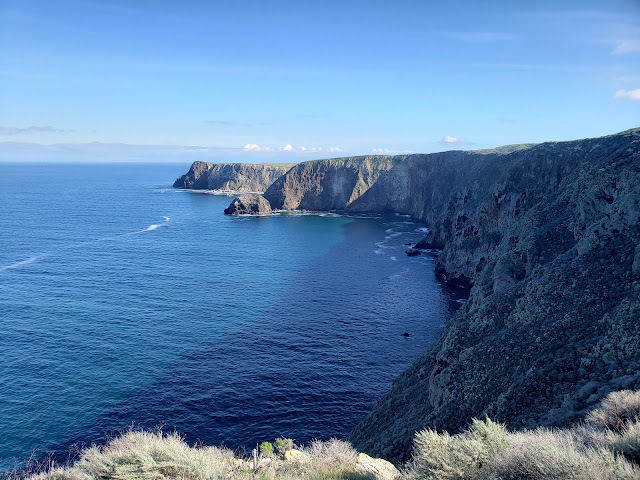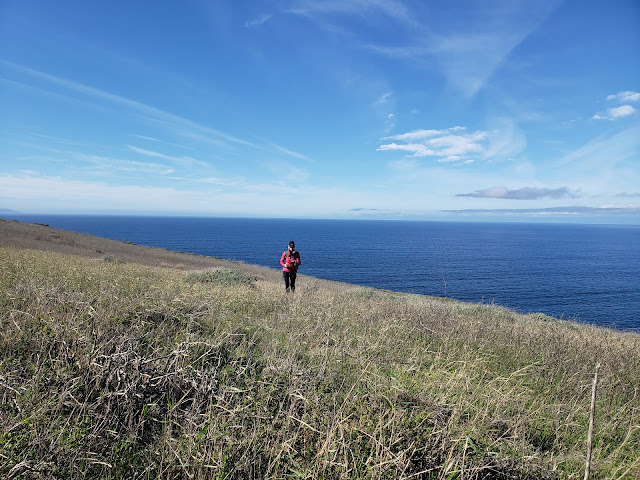The Captain announced that the seas would be choppy that day as we crossed the channel from the mainland to Santa Cruz Island, a place 25 miles off the coast that the native Chumash called Limuw. If you were prone to sea-sickness, the crew advised that the rear deck of the boat was the most stable place to be. Locking yourself in the only bathroom on board was not only ineffective, but it would make things worse as there was no sight-line to the horizon. Plus it was rude to your fellow passengers. Don’t do it. Barf bags would be provided to anyone who found themselves in significant gastric distress.
Out of the harbor just past the breakwater, the northwest swells hit and passengers squealed as the boat chugged to the crest of one swell and then dropped into the trough of the next. Those standing starboard or on the bow were forced to retreat into the cabin to avoid being subjected to continuous spritzing while those on the upper deck maintained watch for dolphins and migrating cetaceans. As the seaworthy vessel tossed and rolled in the turbulent ocean currents, I thought of the grit and courage of the Chumash who once rowed across these same cold waters in tomols hewed by hand from redwood and pine.
For about an hour or so we plied the continuous surge until the pier at Scorpion anchorage came into view. Here, the sea faded from a deep midnight blue to a translucent turquois dotted by the dark green kelp forests that proliferate in these protected waters. It was a kaleidoscopic orgy for the eyes. I was feeling a bit oogy from the trip as the engines died and we moored against the newly-renovated pier, so appreciated getting my landlubber’s feet back onto terra firma.
It isn’t quite clear how or why the anchorage and the historic ranch here were named “Scorpion.” The National Park Service speculates that the designation could refer to either the shape of the valley or the fact that small scorpions are present. Either way, the name certainly isn’t native. Long before Juan Rodriguez Cabrillo arrived in 1542, the Chumash called this place Swaxil. It was the largest of 10 Chumash villages scattered around the island that was home to approximately 1,200 native people. Xaxas (pronounced “hä’ häs”), located at what is now known as Prisoners Harbor, was the second largest village on the island. In total, there are an estimated 3,000 prehistoric native sites on the island ranging from small ephemeral camps to formal villages. But that is all that remains of the original inhabitants. The last of the Chumash islanders were either killed by disease or forced from their ancestral lands by European colonization.
A trip to this island used to be a family tradition. When the kids were young, we’d make the journey with them every New Year’s Day while the rest of the world slept off its hangover. Now visits are more sporadic although there really is no objectively good reason for that. Maybe it’s because from the coast, the islands only exist in a distant, dream-like haze. You can see them sitting on the horizon, but you never quite know whether they’re real or just apparitions. So they end up as nothing but familiar backdrop to the vast blue oceanscape, easy to look past when you’re immersed in everyday living.
Off the boat and on the pier, we were all corralled by a Park Service docent for a mandatory briefing. One lady tried to sneak by without stopping to receive instructions, but the ever-vigilant docent barked her back into place. Most of what we were forced to listen to was common sense stuff that we’d heard multiple times previously. Don’t trample the native vegetation. Stay on the established trails. It’s a federal crime to take anything from or disturb midden sites. There’s potable water on the island, but not food. Carry out your trash. You’d think folks wouldn’t need to be told any of this, but there’s always that one guy who was either raised by animals or who just doesn’t give a shit. So the obvious needs to be repeated out loud to everyone just to make sure that this one dumb asshole hears it even though he still won’t abide.
When the lecture was finished, everyone scattered like fifth graders freed from school for the summer. We got out in front of the mad rush and started up the easy service road leading to Cavern Point. We typically go the other direction toward Montañon Ridge and Smuggler’s Cove, but opted for the north-side views this trip. About half-mile up the road, near the intersection with the North Bluff Trail, things started to get sloppy due to the recent rains. We looked at the path leading to Cavern Point, but declined the invitation. The footpath leading to the point was a muddy, mucky mess.
Instead, we headed west along with North Bluff Trail, a relatively level path that parallels the escarpment for a couple of miles out to Potato Harbor. It was a blue bird day and the views north and west were satisfying. If you’re a plant nerd, the flora on the bluff was also quite interesting. We noticed Giant Coreopsis (aka Truffula Trees) on the cliff edges that had emerged from summer dormancy to show off its finest spring greenery. We also saw plump Live-Forevers (Dudleya), Lemonade Berry, and a few other native and non-natives that all looked quite robust and healthy. We kept eyes out for the endemic Island Jay and Island Fox, but got skunked.
The closer we got to Potato Harbor, the sloppier the path (now a road) became. To avoid the slippery mud, folks were walking the edges and trampling the vegetation. This is how paths widen and erode. We refused to play that game and defiantly trudged along right in the middle of the road, allowing the gooey, sticky mud to accumulate on the soles of our shoes like heavy pancakes. Unsurprisingly, no one else followed our lead. If they understood the point we were trying to make, they didn’t’ care. Principle must always take a back seat to clean shoes, especially when hiking.
A good deal of mud later, we arrived at the overlook for Potato Harbor, so named for its tuber-like shape. Over the cliffs here, you look right down into the aquamarine waters of the isolated harbor. You can also see a good portion of the western side of the island which is owned by the Nature Conservancy and thus off-limits to us commoners. Given the destructive and exploitative history of the place, that’s probably not a bad thing ultimately.
There are several bare patches of diatomaceous soil near the overlook. Diatomaceous earth is bright-white, chalky, sedimentary rock derived from single cell organisms made of silica called diatoms. When dissolved in water and recrystallized, diatomaceous earth forms a hard glass-like substance called chert. The native Chumash mined chert to make arrowheads, drill bits, and scraping tools. They also used it to bore holes in Olivella snail shells to create beads for trade. The abundance of chert on eastern Santa Cruz Island explains the several sites that archeologists have described as Chumash “bead factories.”
We grabbed a seat in the cherty dirt and had a snack while listening to the ocean raging against the island’s north shore. Several other folks were doing the same. When we were finished, we started back to Scorpion anchorage along the same route we used coming out, but dropped down to the campground by way of the trail adjacent to the service road. The campground was very nice and smelled of cool menthol from the grove of non-native Blue Gum Eucalyptus that was planted here as a windbreak back during the ranching era. Then it was a short stroll to the pebbly beach where we lounged around waiting for the boat ride back across the channel.
Back on the boat, the crew opened up the snack bar and I contemplated a can of beer to smooth out the ride back, but decided against it. I didn’t feel like getting gouged for a can of weak, shitty beer only to be left more sleepy than I was already. When we pulled into Ventura Harbor, I noticed that the boat had a single tap handle from none other than Island Brewing Company and I immediately regretted my prior decision. Beer from Island Brewing is always worth the price you pay both in dollars and effect. So I guess I’ll just have to make another trip across the channel in the near future to have an Islands beer on my way back from the islands.




































